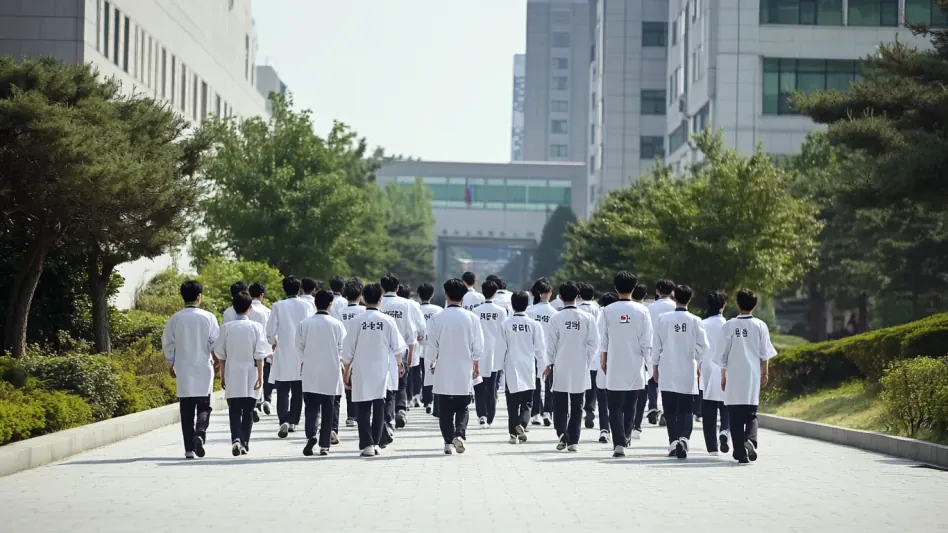Amid an alarming crisis in South Korea’s medical education system, the government’s decision to revert the medical school admission quota to 3,058 students for the upcoming academic year has significantly intensified the debacle. This move comes in response to fervent resistance from the medical community following an earlier, controversial increase in quotas. Last year, the government had sought to boost the number of admissions substantially by 1,500 seats as part of an expansive reform agenda, only to face severe backlash from medical students and professionals alike. While this initial surge in quotas aimed at addressing predicted future shortages in healthcare providers, its hasty implementation and lack of thorough engagement with key stakeholders led to widespread discontent and operational disruptions within hospitals.
Efforts to Resolve the Ongoing Standoff
Education Minister Lee Ju-ho communicated the decision in anticipation of compelling medical students, who had refused to attend classes and clinical training, to return to their educational pursuits. He declared that the reduced quota plan would be enacted only if students resumed their studies by month-end, exhibiting the government’s conditional concession in light of ongoing protests. This was no small declaration, as these demonstrations saw students and trainees collectively abandoning their roles for over a year. This protracted protest has in turn precipitated a precarious situation where the pipeline of new medical professionals may become untenable, leading to severe ramifications including a lack of new medical trainees, military doctors, and public health practitioners if the impasse remains unresolved.
Government officials, however, faced criticism for readily capitulating to students without ensuring their commitment to return. Without a firm assurance from the boycott participants, there remains the lingering question of whether this rollback is a viable long-term solution or merely a temporary reprieve. The detailed survey data by authorities remain stark: A significant majority, specifically 96 percent of students admitted between 2019 and 2024, expressed intentions to continue their break from the semester, pointing to profound indecision within the student body.
Long-Term Implications on Medical Education
The initial implementation of the exorbitant increase spurred a crisis in the medical community, resulting in a mass exodus of medical trainees from their positions and creating operational strains within hospitals. This was exacerbated by insufficient dialogue with the medical community, whose participation is crucial for smooth transitions within the healthcare education system. Emergency and intensive care units, vital to public health, were disproportionately affected, facing difficulties in staffing and resource allocation. By freezing the medical school admission quota at the previous benchmark for another year, governmental officials likely hoped that students would return to classes, finish their medical training, and subsequently promote their rights more effectively thereafter.
However, this well-intentioned strategy may be facing significant hurdles. For one, the medical community has continually highlighted systemic issues that remain unaddressed. Problems such as low profitability in essential health services, subpar working conditions for medical trainees, and the looming threat of excessive lawsuits against doctors persist. Each of these factors contributes to the broader reluctance seen among students to continue their education under the current circumstances.
The Path Forward and Necessary Reforms
Education Minister Lee Ju-ho announced that the plan to reduce the quota for medical students would only proceed if the students, who had boycotted classes and clinical training, returned to their studies by the end of the month. This decision represents a conditional concession from the government amid ongoing protests. These protests have been significant, with students and trainees collectively walking out for over a year. The extended absence has created a precarious situation, potentially jeopardizing the future influx of new medical professionals, which could lead to a shortage of medical trainees, military doctors, and public health practitioners if not resolved.
Criticism has emerged, however, toward government officials for seemingly yielding to student demands without securing their commitment to return. This raises doubts about whether the rollback is a sustainable solution or just a temporary fix. Survey data by authorities reveal a dire outlook: a significant majority, namely 96 percent of students admitted between 2019 and 2024, intend to continue boycotting the semester, highlighting deep uncertainty within the student body.









